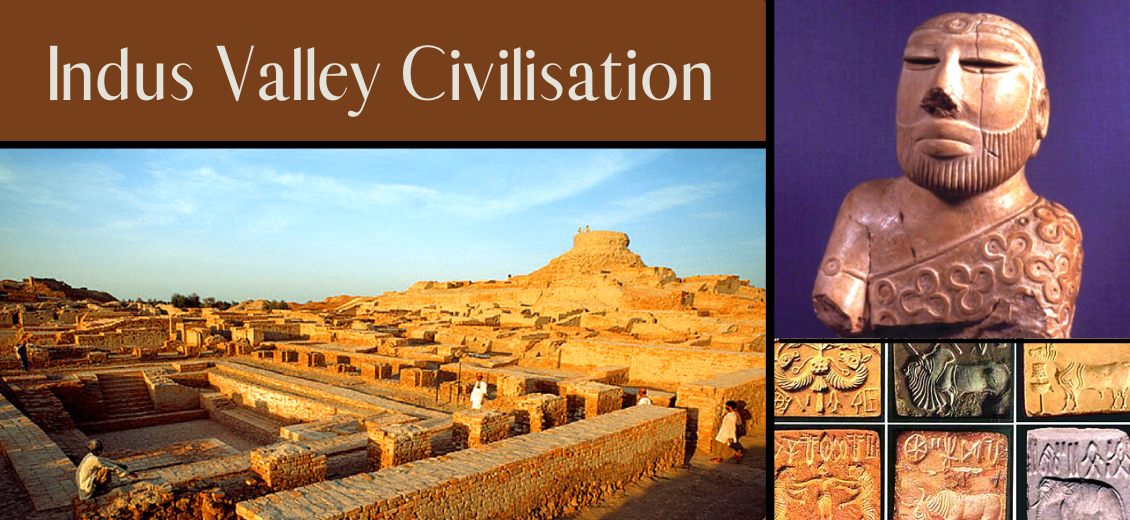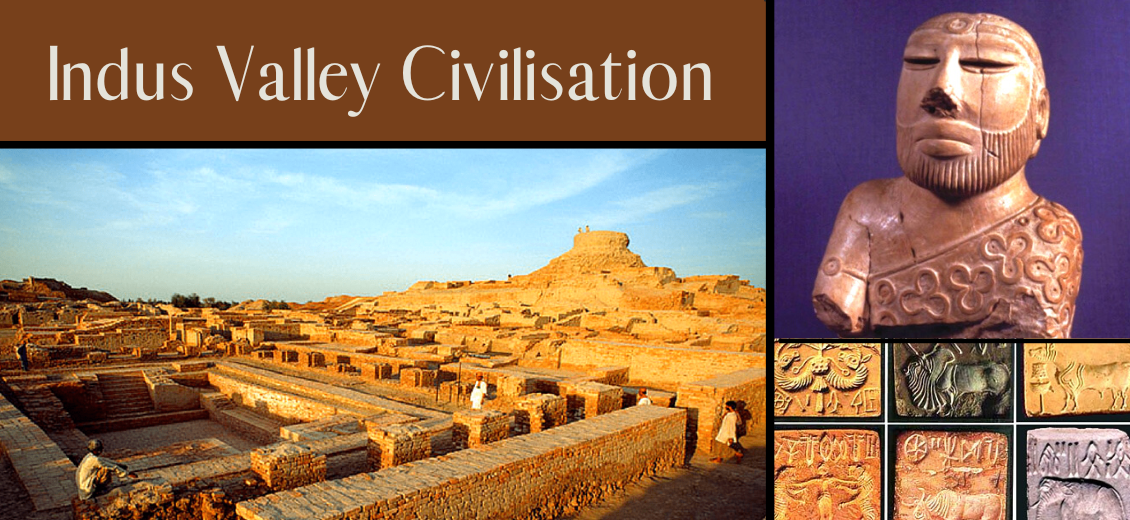
01 Jan 1970
Indus Valley Civilization history GK Quiz Test is useful for those students who are preparing for all Government and competitive exams like SSC CGL, CHSL, CPO, Steno, Banking Exams (SBI PO, IBPS SO, RRB Grade D, LIC AAO), UPSC Civil Service Exams.

25 QUIZ About INDUS VALLEY CIVILIZATION Part 2
Indus Valley Civilization
Indus Valley Civilization history GK Quiz Test is useful for those students who are preparing for all Government and competitive exams like SSC CGL, CHSL, CPO, Steno, Banking Exams (SBI PO, IBPS SO, RRB Grade D, LIC AAO), UPSC Civil Service Exam, CDS, Police, Railway, AAI, NDA, Post Office Exams, BPSC, ACEE, AIEED, APPSC, MPPSC, GPSC, OPPSC, UPPSC, UPSSSC and All-State Selection Commission Exams, and all other one day competitive exams also.
In this set we included important previous year questions also, so start todays test and boost your preparation with Sv Study Alert.
1. Question: Which animal was not commonly represented in the art and seals of the Indus Valley Civilization?
A) Elephant
B) Bull
C) Lion
D) Horse
Solution: D) Horse
Explanation: While the bull, elephant, and lion were commonly depicted in Indus Valley art, there is limited evidence of horse representations. Horses became more prominent in later cultures.
2. Question: What is the name of the famous sculpture found at the site of Mohenjo-daro, depicting a seated male figure?
A) Dancing Girl
B) Priest King
C) Mother Goddess
D) Harappan Ruler
Solution: B) Priest King
Explanation: The famous sculpture found at Mohenjo-daro is known as the "Priest King," depicting a seated male figure wearing a distinctive headdress.
3. Question: Which of the following is considered an advanced feature of the Indus Valley Civilization's urban planning?
A) Absence of granaries
B) Multi-story houses
C) Lack of public wells
D) Uniformly sized houses
Solution: B) Multi-story houses
Explanation: Evidence suggests that some houses in the major Indus Valley cities had multiple stories, indicating an advanced understanding of architectural techniques.
4. Question: What is the term used for the small seals found in the Indus Valley, often depicting animals and inscriptions?
A) Micro Seals
B) Mini Seals
C) Scripted Seals
D) Harappan Seals
Solution: A) Micro Seals
Explanation: The small seals found in the Indus Valley, often depicting animals and inscriptions, are referred to as Micro Seals.
5. Question: Which of the following metals was not widely used by the Indus Valley Civilization?
A) Gold
B) Silver
C) Copper
D) Iron
Solution: D) Iron
Explanation: While copper and bronze were widely used, there is limited evidence of iron usage during the Indus Valley Civilization. Iron became more prevalent in later periods.
6. Question: What was the likely purpose of the platforms found in the Indus Valley cities?
A) Marketplaces
B) Residential spaces
C) Ritual or ceremonial purposes
D) Administrative centers
Solution: C) Ritual or ceremonial purposes
Explanation: The purpose of the platforms found in the Indus Valley cities is not definitively known, but some scholars suggest that they may have been used for ritual or ceremonial purposes.
7. Question: Which artifact found in the Indus Valley sites is believed to have been used for making impressions on clay?
A) Chariot
B) Seal
C) Sword
D) Figurine
Solution: B) Seal
Explanation: Seals found in the Indus Valley often had intricate designs and inscriptions. They are believed to have been used for making impressions on clay, possibly for trade or administrative purposes.
8. Question: What evidence suggests that the Indus Valley people were engaged in long-distance trade?
A) Seals with multiple inscriptions
B) Uniform pottery across sites
C) Presence of exotic materials
D) Absence of external contacts
Solution: C) Presence of exotic materials
Explanation: The presence of exotic materials, such as lapis lazuli from Afghanistan, suggests that the people of the Indus Valley Civilization were engaged in long-distance trade.
9. Question: What is the term used for the unique system of writing found in the seals of the Indus Valley Civilization?
A) Harappan script
B) Indus script
C) Pictographic script
D) Hieroglyphic script
Solution: B) Indus script
Explanation: The writing system found in the seals of the Indus Valley Civilization is often referred to as the Indus script. However, it remains undeciphered.
10. Question: Which river was considered the westernmost limit of the Indus Valley Civilization?
A) Ganges
B) Yamuna
C) Sutlej
D) Jhelum
Solution: D) Jhelum
Explanation: The Jhelum River is considered the westernmost limit of the Indus Valley Civilization. It marked the extent of their influence in that direction.
11. Question: What was the purpose of the large platforms with stairs found in the Indus Valley cities?
A) Religious ceremonies
B) Administrative functions
C) Residential spaces
D) Marketplaces
Solution: A) Religious ceremonies
Explanation: The large platforms with stairs found in the Indus Valley cities are believed to have been used for religious ceremonies or public gatherings.
12. Question: What is the term used for the small, square-shaped seals with animal motifs found in the Indus Valley?
A) Micro Seals
B) Square Seals
C) Animal Seals
D) Terracotta Seals
Solution: B) Square Seals
Explanation: The small, square-shaped seals with animal motifs found in the Indus Valley are commonly referred to as Square Seals.
13. Question: Which material was commonly used for making the distinctive pottery of the Indus Valley Civilization?
A) Red clay
B) Terra-cotta
C) Black stone
D) Steatite
Solution: D) Steatite
Explanation: The distinctive pottery of the Indus Valley Civilization was often made from steatite, a soft stone that allowed for intricate designs.
14. Question: What evidence suggests that the people of the Indus Valley had a well-developed system of weights and measures?
A) Standardized bricks
B) Metal figurines
C) Beads and jewelry
D) Cubical weights
Solution: D) Cubical weights
Explanation: Cubical weights found in the Indus Valley indicate a well-developed system of weights and measures, essential for trade and economic activities.
15. Question: Which of the following was a feature of the Great Bath in Mohenjo-daro?
A) Multi-level structure
B) Mosaic floor
C) Heated water
D) Ritual bathing
Solution: D) Ritual bathing
Explanation: The Great Bath in Mohenjo-daro is believed to have been used for ritual bathing, and it is one of the significant structures of the Indus Valley Civilization.
16. Question: Which of the following metals was commonly used for making tools and implements in the Indus Valley Civilization?
A) Gold
B) Silver
C) Copper
D) Bronze
Solution: C) Copper
Explanation: Copper was a commonly used metal for making tools and implements in the Indus Valley Civilization. Bronze, an alloy of copper, was also utilized.
Also, below are a few links that may help you score more in the upcoming Government exams: Free Mock Test Series with Solutions Previous Year Government Exams Question Papers PDF with Solutions Daily Current Affairs Free Job Alert ढूंढ रहे हैं सरकारी नौकरी या लेना है कॉलेज में एडमिशन, शिक्षा से लेकर जॉबअलर्ट तक हर लेखा जोखा है SV Study Alert के पास। जॉब अपडेट्स के लिए आज ही फॉलो करें हमारा व्हाट्सअप चैनल - यहां क्लिक करें Are You Looking For A Government Job Or Want To Take Admission In College?, SV Study Alert Has Every Detail From Education To Job Alert. Follow Our Whatsapp Channel Today For Job Updates - Click Here Now NOTE- Svstudyalert.com द्वारा सभी स्टडी मटेरियल हिंदी और अंग्रेजी दोनों भाषाओं में उपलब्ध कराया जाता है ऊपर दिए गए बटन “Choose Your Language” पर क्लिक करके आप सभी स्टडी मैटेरियल हिंदी / अंग्रेजी किसी भी माध्यम में प्राप्त कर सकते हैं |